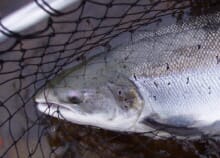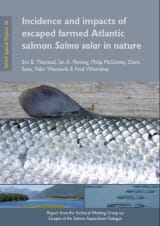Salmon is a favoured consumer fish with growing demands that need to be met. In response to market pressures and insufficient wild stock, salmon farms the world over are expanding at a phenomenal rate.
According to Living Oceans, a non-profit organization committed to the preservation of marine biological diversity and creation of sustainable fisheries, "to meet increasing world demand for salmon, without placing undue pressure on wild stocks, salmon aquaculture is both necessary and beneficial." - but there is more than just a good meal being cultivated in these farms.
It has long been known that disease and pollution from these farms take a serious toll on the environment around them, but the latest research suggests that the potential threat of escaped salmon may have a much bigger impact than was previously feared.
According to the latest report by the Technical Working Group on Escapes of the Salmon Aquaculture Dialogue, escapes from fish farms occur from marine net pens in all salmon producing countries, as both repeated “trickle” losses of relatively small numbers of fish, and through large-scale episodic events such as storms.
It is estimated that some two million Atlantic salmon escape each year from fish farms in the North Atlantic - equivalent to half the total number of wild adult salmon in the sea, but despite requirements for mandatory reporting, the magnitude of unreported escapes is unknown.
Norway, Chile, Scotland and Canada are the largest producers (46, 31, 10 and 7 per cent respectively of total production in 2005), but there have been frequent observations of escaped farmed salmon crossing national borders. Usually they are recorded within 500 km of the escape site, but some have been found as far as 2000-4500 km from their origin. Clearly, this has become an international issue.

A Storm is Brewing
The report, Incidence and impacts of escaped farmed Atlantic salmon Salmo salar in nature, says: "potential negative effects by escaped farmed salmon on wild salmon populations have been scientifically documented. Negative effects include both ecological interactions and genetic impacts of inter-breeding. A large number of studies point to negative effects, and outcomes for wild populations are either mostly negative and at best neutral". The report goes on to point out that "inter-breeding of farm with wild salmon can result in reduced lifetime success, lowered individual fitness and decreases in production over at least two generations."
Global farmed salmon production is largely based on a few breeding strains, developed for maximum return and quick growth. However their wild cousins are the products of thousands of years of evolution, fine tuned in accordance with the highly challenging environmental pressures around them.
Therefore the morphology of farmed salmon, altered for both producer and consumer, is at a disadvantage. Hampered by reduced body streamlining, shorter fins, higher fat content, reduced swimming performance and differently shaped hearts, the farmed salmon are less prone to survival in open waters.
This alone is not a problem. Escaped salmon often interbreed with wild fish stocks. This has a detrimental effect on the wild salmon gene pool, consequently lowering their survival rate.
In a ten year study it was estimated that 70 per cent of these hybrid fish died in the first few weeks of life, whilst those that did survive could then go on to contaminate the gene pool once again.
Inspite of this, there is evidence that the farmed salmon actually have a competitive edge over their wild cousins at an early stage in their lives because of a more agressive nature and quicker growth patterns.
Farmed salmon and hybrids can be expected to interact and compete directly with wild salmon for food, habitat and territories, adding extra pressure to their depleting stocks
A Problem That is Here to Stay?
The study also attempted to understand the threats posed by escaped farmed salmon in regions where the Atlantic salmon is an exotic species.
In 2005, 36 per cent of the total world production was in regions where the species is exotic. Questions relevant to the escape issue include whether escaped Atlantic salmon can establish self-reproducing populations in these regions, whether they are able to hybridize with native fish, and what ecological effects might escaped salmon have on native species and ecosystems.
Historical attempts to introduce anadromous populations of Atlantic salmon around the world have failed generally, indicating that the Atlantic salmon is a poor colonizer outside its native range.
However, mature escaped Atlantic salmon are recorded in freshwater streams in British Columbia, Canada, and there is evidence of successful spawning of Atlantic salmon in three streams.
Preventative Meaures

A prerequisite for escape prevention is knowledge of why, when and from where salmon escape. Often the information collected on such issues can be inadequate to truly understand the problem.
There is also continuous research and development to improve cage technologies and operating methodologies. Novel or alternative technologies, however, have been slow to develop to date. A Norwegian standard has been developed that specifies technical requirements for the dimensioning, design, installation and operation of floating fish farms. This standard is the first of its kind on an international level, and Norway is currently working on globalisation of the standard through the ISO.
According to the report, the use of sterile salmon is a measure that should be carefully appraised, considering the positive effects it could have on reducing direct genetic effects of farmed salmon on wild salmon populations. It may also reduce ecological effects.
However, it is unlikely to greatly reduce threats from the transmission of diseases and parasites. The most effective method of sterilising Atlantic salmon is high pressure induction of triploidy in newly fertilised eggs.
Triploids have a number of disadvantages in commercial aquaculture, but results from different studies vary with regard to triploid growth, survival and the occurrence of deformities.
Use of triploid (i.e. sterile) salmon in commercial farming would require research and development to determine optimum rearing conditions and boost triploid disease resistance. Ecological interactions of farmed sterile fish with wild fish must be critically evaluated before large-scale use of sterile fish can be encouraged.
Domesticating cultured fish to the point where they are unable to breed successfully in nature, or even to survive in nature, could be an effective means of reducing or eliminating genetic and ecological threats to wild populations.
However, this would potentially be a complicated and long-term process to select for truly domesticated farmed salmon, while at the same time not affecting characteristics that may reduce the culture yield.
Protection zones where salmon farming is prohibited may be an effective way of protecting wild salmon populations. Such zones have been established in fjords in both Norway (pre-existing farms however were not always relocated) and in Iceland. Only a few zones seemed to provide the intended effect of reducing the proportion of escaped farmed salmon in nearby rivers, according to a preliminary evaluation in Norway.
Despite the fact that the aquaculture industry offers such a great solution to the oceans problems, its progress is continually hampered by complex and often unforseen developments. One day, wild salmon stocks may revive themselves to their former numbers, but their survival may hang on to be a race against time, awaiting the realisation of aquaculture's true potential.
Further Reading
| - | Find out about the Feasibility of Closed Containment Saltwater Salmon Aquaculture Systems by clicking here. | |
| - | View the report, Incidence and impacts of escaped farmed Atlantic salmon Salmo salar in nature, by clicking here. |
October 2008


